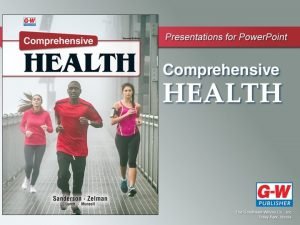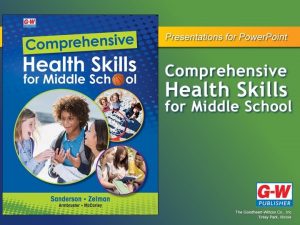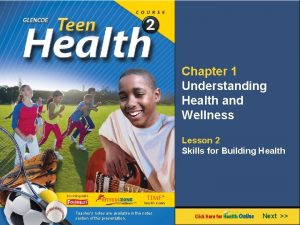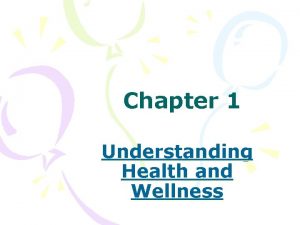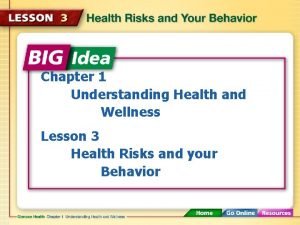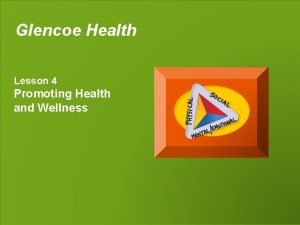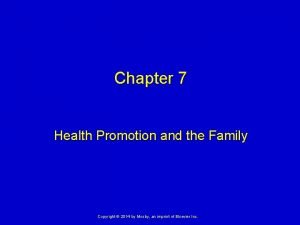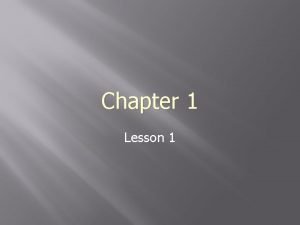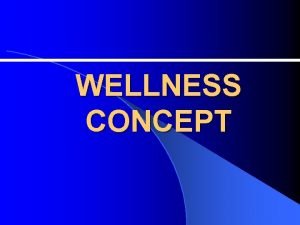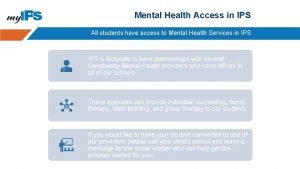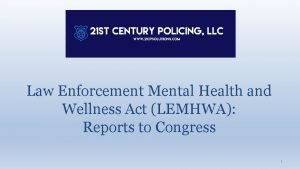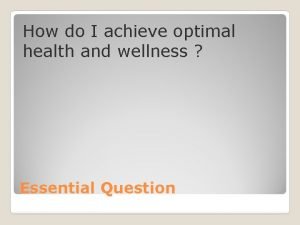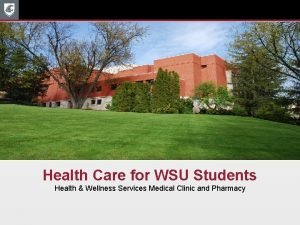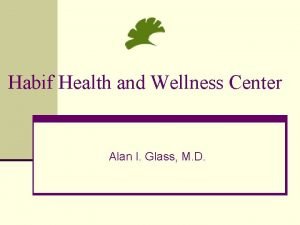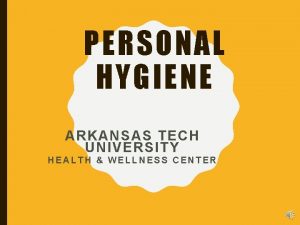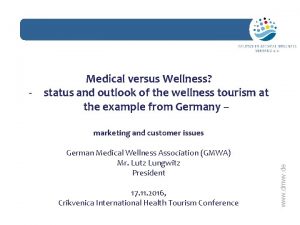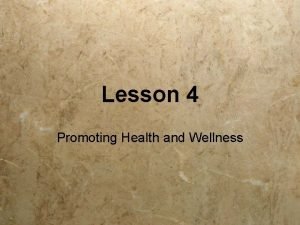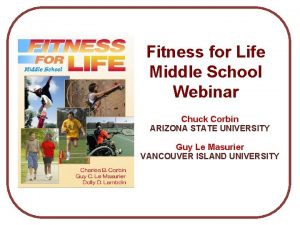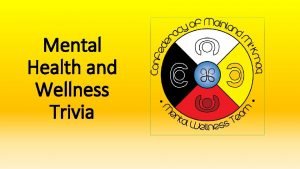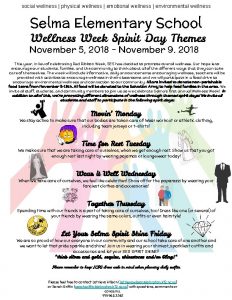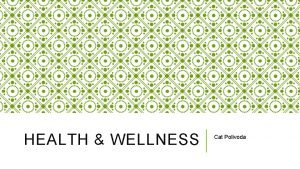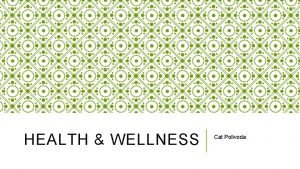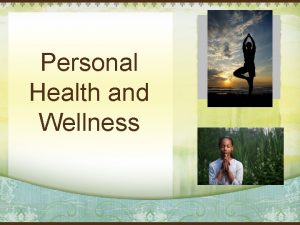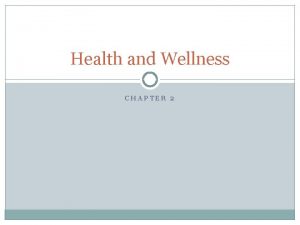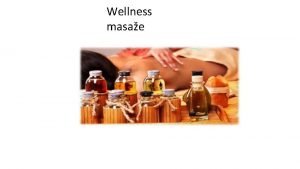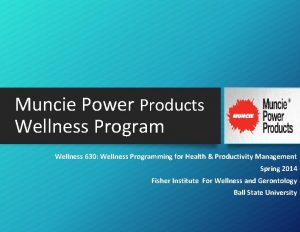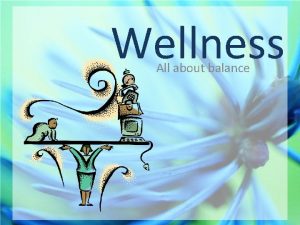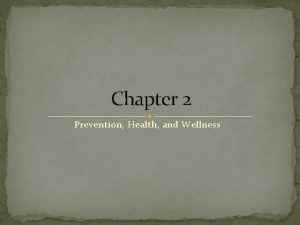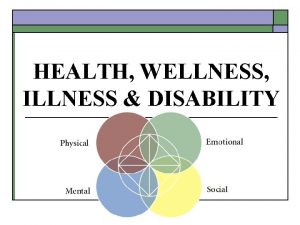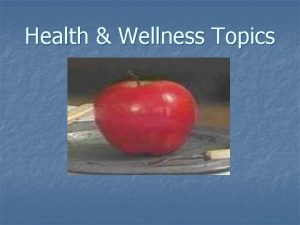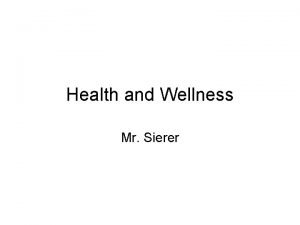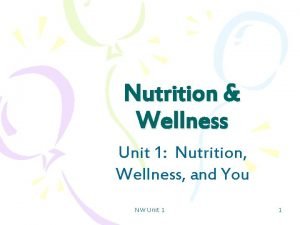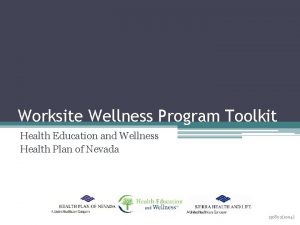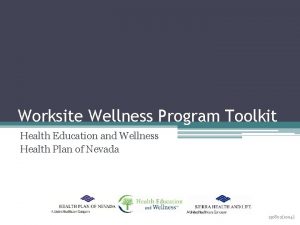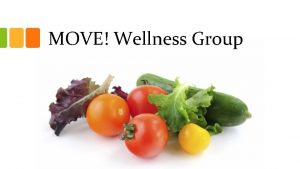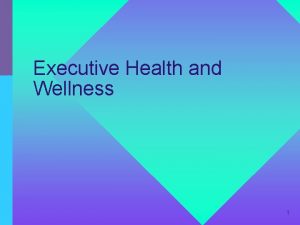Chapter 1 Understanding Health and Wellness Health YOU



























- Slides: 27

Chapter 1 Understanding Health and Wellness

Health

YOU ARE RESPONSIBLE FOR YOUR OWN HEALTH Health – is the combination of physical, mental/emotional, and social wellbeing. Wellness – an overall state of well-being, or total health (balanced life)

Health Triangle 3 Main Parts of Health 1) Physical Health – body functions - exercise, food, avoid injury, medical checkups, sleep, avoid drugs/alcohol 2) Mental/Emotional Health- mind - learning new things, dealing with emotions, taking responsibility for actions, dealing with disappointment 3) Social Health – getting along with others - friends, communicating, seeking & lending support when necessary

Physical Health • Get 8 hours of sleep each night • Eat nutritious meals and drink 8 cups of water a day • Engage in 30 -60 minutes of physical activity • Avoid the use of tobacco, alcohol, and other drugs • Practicing good hygiene

Mental/ Emotional Health • • Enjoys challenges that help them grow Accepts responsibility for their actions Has control of their life Can express their emotions appropriately Deal with life’s stresses and frustrations Positive outlook Make thoughtful and responsible decisions

Social Health • Seeking and lending support when needed • Communicating clearly and listening to others • Showing respect and care for yourself and others

CREATE YOUR PERSONAL HEALTH TRIANGLE

Influence on your Health 1) Heredity – all the traits that are biological (Good AND Bad) 2) Environment – is the sum of your surroundings – physical environment – social environment – culture 3) Attitude- way you view situations 4) Behavior – how you act 5) Media – methods of communicating (radio, tv, internet, newspapers); play a powerful role in shaping public opinion 6) Technology –radio, television, the internet, etc -advances in technology can be positive and negative

20 THINGS • List 20 things you like to do • Put a heart next to the things you love • Put a $ next to the things that cost money – If more then $20 add two $$ • Next to each thing, write down the last time you did each of them • Put a next to things you do with others • Put a 1 next to things you do alone • Circle things you do in the community • Put a check mark next to things that contain physical activity • Put a star next to things that make you feel relaxed

I USED TO…. . BUT NOW I

7 Components of Wellness Each of these seven dimensions act and interact in a way that contributes to our own quality of life

Physical • The ability to maintain a healthy quality of life that allows us to get through our daily activities without fatigue or physical stress • The ability to recognize that our behaviors have a significant impact on our wellness and adopting healthful habits – routine check ups – a balanced diet – Exercise – avoiding destructive habits (tobacco, drugs, alcohol, etc. )

Social • The ability to relate to and connect with other people in our world • Our ability to establish and maintain positive relationships with family, friends and co-workers

Spiritual • The ability to establish peace and harmony in our lives • The ability to develop congruency between values and actions and to realize a common purpose that binds creation together • Understanding your purpose and direction in life • Does not necessarily mean one has to be religious; but it can be included

Intellectual • The ability to open our minds to new ideas and experiences • The desire to learn new concepts, improve skills and seek challenges in pursuit of lifelong learning • Keeping one’s mind active and continually learning

Emotional • The ability to understand ourselves and cope with the challenges life can bring • The ability to acknowledge and share feelings of anger, fear, sadness or stress; hope, love, joy and happiness in a productive manner

Environmental • The ability to recognize our own responsibility for the quality of the air, the water and the land that surrounds us • The ability to make a positive impact on the quality of our environment – At home – At school – In the community

Occupational • The ability to get personal fulfillment from our jobs or our chosen career fields while still maintaining balance in our lives • Our desire to contribute in our careers to make a positive impact on the organizations we work in and to society as a whole

Preventing Risk Factors Prevention – practicing health and safety habits to remain free of injury and disease Protective factor – increases possibility of positive outcome Risk Behaviors– actions that threaten your health

6 categories of Risk Behaviors in Teens • • • Behaviors that result in injuries Tobacco use Alcohol & drugs Sexual behaviors Poor Diet Lack of Physical Activity


Abstaining from risk behaviors Abstinence – avoiding harmful behaviors Alcohol/Drugs – harmful psychological effects, cause addiction, death, legal consequences Sexual Activity – unplanned pregnancy, STI’s, emotional problems, single parent

Life Style Factors The personal habits or behaviors related to the way a person lives. • • Getting 8 hours of sleep each night Starting the day with a healthy breakfast Eating a variety of nutritious foods each day Being physically active for 30 -60 minutes most days of the week • Maintaining a healthy weight • Abstaining from using drugs

• Health Literacy- person’s capacity to learn about and understand basic health information and services and use these resources to promote health. Someone who is health literate is also: 1) Effective Communicator – expresses knowledge 2) Critical Thinker/Problem Solver –evaluates health info before making a decision 3) Self-Directed Learner –develops evaluation criteria for health info 4) Responsible Citizen – promotes health in community

3 Parts of Health PSA • You need a word and a picture for each element of health (i. e. a word and picture for social etc. ) • On a separate sheet of paper, write a paragraph on why you chose each word.

Example of 3 Parts of Health PSA Friends Running Reading
 Chapter 1 lesson 2 what affects your health
Chapter 1 lesson 2 what affects your health Understanding health and wellness chapter 1
Understanding health and wellness chapter 1 The ability to locate interpret and apply information
The ability to locate interpret and apply information Goodheart willcox chapter 1 answers
Goodheart willcox chapter 1 answers Understanding your health and wellness
Understanding your health and wellness Lesson 4 promoting health and wellness
Lesson 4 promoting health and wellness Chapter 1 lesson 2 what affects your health
Chapter 1 lesson 2 what affects your health Chapter 1 understanding your health and wellness
Chapter 1 understanding your health and wellness Chapter 1 understanding health and wellness lesson 3
Chapter 1 understanding health and wellness lesson 3 Chapter 3 health wellness and health disparities
Chapter 3 health wellness and health disparities Chapter 1 lesson 4 promoting health and wellness
Chapter 1 lesson 4 promoting health and wellness Chapter 7 promoting health and wellness
Chapter 7 promoting health and wellness Chapter 1 lesson 4 promoting health and wellness
Chapter 1 lesson 4 promoting health and wellness 6 aspects of wellness
6 aspects of wellness Ips health and wellness
Ips health and wellness Law enforcement mental health and wellness act
Law enforcement mental health and wellness act How to achieve optimal health and wellness
How to achieve optimal health and wellness Heartland health and wellness
Heartland health and wellness Wsu health insurance
Wsu health insurance Alan glass washu
Alan glass washu Soar to health and wellness
Soar to health and wellness Atu health and wellness
Atu health and wellness Wellness network marketing
Wellness network marketing Lesson 4 promoting health and wellness
Lesson 4 promoting health and wellness Stairway to lifetime fitness health and wellness
Stairway to lifetime fitness health and wellness Stairway to lifetime fitness health and wellness
Stairway to lifetime fitness health and wellness Ruth ellis health and wellness center
Ruth ellis health and wellness center Health and wellness trivia
Health and wellness trivia


